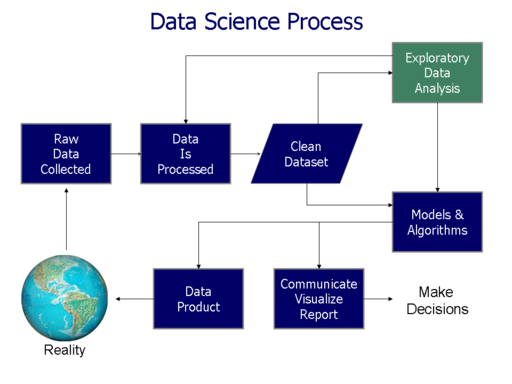Data Analyst
The data analyst and the data scientist are senior managers in the management and analysis of “massive data” (Big data). These specialists in figures, statistics and computer programs process a company’s data to extract the information likely to help it in its decision-making. Unlike the data scientist who has a transverse vision, the data analyst supports a specific type of data.
What is the importance of data analysis?
The objective of data analysis is to extract statistical information that makes it possible to identify more precisely the profile of the data. The results obtained are then used to optimize the strategy of the company in question by adjusting certain points.
Data Analyst is also known as Data Miner Business Analyst, Business Intelligence (BI) Analyst and BI Manager.
There are several types of jobs in data:
- Data analyst
- Business intelligence analyst
- Data scientist
- Data engineer
- Big Data Architect
- And many others !
It is important to know how to distinguish these different profiles as it should be. For example, let’s compare the first 3 professions on this list.
A data analyst:
- Takes care of the collection, cleaning and analysis of a company’s data
- Mastery of Machine Learning algorithms to model data and predict trends (he specializes in
- modeling and interpreting the latter)
- Creates detailed statistical reports adapted to the needs of the company
A Business Intelligence analyst (BI analyst), meanwhile:
- Accompanies leaders in strategic decision-making and allows them to follow data-driven strategies – these strategies are called “data-driven”
- Aims to automate data collection and reporting, and provide business decision makers with data-driven logic through its expertise
- Uses BI tools and data visualizations
- Combines business and technical skills
And finally, a Data scientist:
- Mainly deals with future data
- Builds predictive and prescriptive analytics using deep learning algorithms
- Predicts market trends
- Implements real-time recommendation systems
What Does a Data Analyst Do?
What are the main responsibilities of the Data Analyst?
The Data Analyst’s mission is to exploit and interpret data to generate useful business observations. Thus, the reports provided make it possible to guide Management decision-making and improve performance and Marketing strategies.
The Data Analyst creates, administers and models the database and ensures regular updates to facilitate its use by the business teams. Indeed, he plays a key role because he is often required to work with several teams and the results provided will have an impact on the growth of the company. The developers will make it easier for him to analyze the data, which he will then make available to the Marketing, Finance, Sales and Management teams.
The missions of the Data Analyst are varied:
- Collection and extraction of relevant and quality data sources which it then translates into statistical data.
- Processing, exploitation and integration of data in a data warehouse (data warehouse).
- Creation of dashboards, implementation of KPIs and performance reporting to give a coherent vision of the results to the different teams.
- Implementation of processes/requests and automation.
- Production of business analyzes and recommendations to managers.
- Management of analysis tools so that internal decision-makers and customers can follow the evolution of their products.
- Technological monitoring of new tools aimed at improving data analysis.
Examples of good data science usage
Healthcare
Data science can be used to analyze medical records, clinical trial data, and other healthcare information to improve patient outcomes and identify new treatments and cures for diseases. Data scientists can analyze medical data to identify patterns and insights that can help improve patient care, reduce costs, and prevent disease outbreaks.
Climate Change
Data science can be used to analyze climate data to identify trends and patterns, and to make predictions about future climate change. This information can be used to inform policy decisions and develop strategies to mitigate the effects of climate change.
Education
Data science can be used to analyze student performance data to identify areas where students are struggling and develop targeted interventions to help them succeed. It can also be used to identify effective teaching strategies and improve curriculum development.
Fraud detection
Data scientists can use machine learning algorithms to detect fraudulent transactions in financial institutions, such as credit card companies.
Predictive maintenance
Data scientists can analyze large amounts of data from sensors and other sources to predict when machines or equipment are likely to fail, allowing for preventive maintenance.
Customer segmentation
Data scientists can analyze customer data to identify different segments of customers with similar characteristics, allowing companies to tailor their marketing efforts to each group.
Natural language processing
Data scientists can use natural language processing techniques to analyze and understand text data, which can be useful for applications such as sentiment analysis, chatbots, and language translation.
Image and video analysis
Data scientists can use deep learning techniques to analyze and understand visual data, such as images and videos, which can be useful for applications such as object detection, facial recognition, and autonomous vehicles.
Social network analysis
Data scientists can use network analysis techniques to understand the structure and behavior of social networks, which can be useful for applications such as marketing, politics, and social media.
Recommender systems
Data scientists can use collaborative filtering and other techniques to recommend products and services to users based on their preferences and behavior.

Data analysis is a process that consists of inspecting, cleaning and transforming data in order to highlight useful information, to suggest conclusions and support decision making. Farcaster at English Wikipedia, CC BY-SA 3.0, via Wikimedia Commons
Examples of bad data science usage
Data science models and algorithms can be opaque and difficult to understand. Lack of transparency can lead to distrust in the results and harm, such as:
Surveillance
The misuse of data for surveillance purposes is a major concern in data science. Data science can be used to collect and analyze personal information about individuals without their consent, leading to violations of privacy and civil liberties. Governments and corporations can collect data on individuals without their knowledge or consent, and use it to track their movements, behavior, and activities. This can violate privacy rights and lead to abuse of power. Read also: Cookie Consent : GDPR (Europe), CCPA (California) and LGPD (Brazil)
Discrimination
Data science can perpetuate existing biases and discrimination by using biased data or algorithms. For example, facial recognition technology has been shown to be less accurate for people of color, leading to potential misidentifications and harm. For example, if a model is trained on data that is biased against a particular group, it will produce biased predictions that can perpetuate discrimination.
Overfitting
Overfitting is one of the most common mistakes in data science. Overfitting occurs when a model is too complex and is able to fit the training data very closely, but performs poorly on new data. This problem can be caused by a variety of factors, including a lack of regularization or an insufficient amount of data.
Sampling Bias
Sampling bias is a type of bias that occurs when the sample used to train a model is not representative of the population it is intended to model. This can lead to inaccurate predictions and poor performance on new data.
Data Manipulation
Data can be manipulated to produce a desired result, such as inflating sales numbers or manipulating financial reports. This can lead to unethical behavior and harm to stakeholders.Data can be misused for nefarious purposes, such as targeting individuals with false information or using data to manipulate public opinion.
Main activities
The main activities of a data analyst include:
Data extraction and structuring
- Extract the data necessary for the analysis (Web scraping, API, etc.).
- Define database cleaning management rules (formatting, deletion of duplicates, etc.).
- Define management rules for structuring the different databases between them.
- Write and draft specifications for the automation of management rules for the information systems department or the contracting authority.
- Control the quality of data throughout their processing.
Data analysis and exploration
- Analyze the data: highlight correlations, define outliers.
- Create dashboards or industrialized reporting tools.
- Perform statistical tests on the data.
- Build and test statistical models (regression, random forest, etc.).
- Determine or construct the important variables to introduce into the statistical models.
Communication with client teams
- Participate in internal needs expression workshops.
- Precisely understand business issues and translate them analytically.
- Communicate results and solutions with business teams.
- Present the results of the analyzes using data visualization tools.
Technology watch on data analysis tools
- Monitor new data analysis technologies and software solutions.
- Research and experiment with new methods of modeling and data analysis.
- Select new data analysis tools and techniques.
Data integration and transformation
- Integrating data from different sources and systems to create a unified and comprehensive dataset.
- Transforming data into a suitable format for analysis, including data normalization, aggregation, and feature engineering.
Data visualization and reporting
- Designing and creating visually appealing and informative data visualizations to effectively communicate insights and findings.
- Generating reports and summaries that convey the key findings, trends, and recommendations derived from data analysis.
Data mining and pattern recognition
- Applying data mining techniques to identify hidden patterns, trends, and relationships within the data.
- Implementing algorithms for clustering, classification, or anomaly detection to discover valuable insights.
Data validation and quality assurance
- Developing and implementing data validation procedures to ensure accuracy, completeness, and consistency of data.
- Conducting data quality assessments and audits to identify and resolve any data issues or anomalies.
Collaboration and teamwork
- Collaborating with cross-functional teams, including data scientists, business analysts, and IT professionals, to gather requirements and align on project objectives.
- Participating in team meetings, brainstorming sessions, and knowledge sharing activities to contribute to the overall data analysis process.
Continuous learning and skill development
- Staying updated with the latest advancements in data analysis techniques, tools, and methodologies.
- Engaging in professional development activities, such as attending conferences, workshops, or online courses, to enhance analytical skills and expand knowledge in the field.
Documentations
- Documenting data analysis processes, methodologies, and findings to ensure reproducibility and facilitate knowledge sharing.
- Maintaining clear and well-organized documentation for future reference and to support collaboration with team members or stakeholders.
Project management and prioritization
- Managing multiple data analysis projects simultaneously, setting priorities, and meeting deadlines.
- Planning and coordinating tasks, resources, and timelines to ensure successful project execution.
Note: The specific activities of a data analyst may vary depending on the industry, organization, and project requirements.
Variability of activities
Data analysts may be responsible for creating dashboards, but also for carrying out more in-depth statistical studies. This is the case in the banking and finance sector for the development of predictive algorithms, the analysis and statistical prevention of economic risks (unpaid bills, loans, investments, etc.).
HIERARCHIC REATTACHMENT
- Data team leader
- Big data division manager
- IT data manager
- Chief data officer
Qualifications required to become a data analyst
To be a successful data analyst, you must first love statistics. Numbers should be one of your favorite ways of speaking! Tables, graphs, reports… Here is a schematic summary of the main working tools of a data analyst.
You must have a perfect command of both computer language and statistical tools. Like any activity requiring the manipulation of encrypted data, you must be endowed with extreme rigor, a developed analytical mind and a foolproof organization. Concentration is also one of the essential skills to make a good data analyst.
If you join a company to carry out this activity, you will of course be required to respect the rules of confidentiality and non-disclosure of sensitive information.
Read also: What is the difference between data science and Big Data?
Knowing how to analyze data means having a very valuable ability to anticipate and predict for companies. A field that is constantly developing and for which profiles with a dual manager-engineer skill with a digital specialization are highly sought after. Ready to get started in data? They are just waiting for you!
Why data analytics is booming?
Between marketing and IT, between mathematics and management, they are able to make data speak to make the right decisions and formulate recommendations and predictions.
A field that is growing more and more, but how far?
The digital data guide
Like most web-related functions, the Data Analyst profession is relatively recent. Its purpose is to explore the data at its disposal with statistical, mathematical and computer tools. Some of these tools are also developed by specialized publishers and Data Scientists. The analyst does not conceptualize the tools, he uses them to find answers to complex problems.
Its purpose is to dissect and explore data in order to be able to provide a relevant analysis to customers. It is a dual profession that is both technical and managerial, because the Data Analyst can work for an agency and be in direct contact with external clients; or for a large group, and support internal customers, such as the marketing or sales department for example.
The digital data collected is only useful if it is analyzed and acted upon.
Data analysis requires a great sense of organization
You also need a good critical spirit and a good capacity for analysis and modelling. But more than anything, you have to love numbers! If Excel is a must, data analysis also and above all involves more specific languages and technologies such as Python or SQL.
Finally, as complex as it may seem, data analysis requires clear and understandable restitution. This is the reason why the Data Analyst should not deliver raw results. He must be a good storyteller to popularize, put into perspective and captivate his audience. A role with very high added value to support business growth.
Data and marketing: an inseparable duo
There has never been so much data. Let’s take a simple example: selling a plane ticket at the best price. For businesses, the goal is to fill devices while maximizing profitability. A difficult equation incorporating hundreds of variables that are all interdependent. Setting the price of a single ticket requires the operation of many algorithms and computer programs that operate continuously and update the data in real time.
All this information is essential for the company, and in particular for marketing. It is indeed thanks to a better knowledge of the data and the critical variables that it becomes possible to make the right decisions at the right time.
Turning raw data into actionable decisions is not a straight path
While large groups understood the impact and importance of data very early on, many companies – including SMEs which represent the majority of companies in France – are still far from it. Data analysis is a springboard and a lever for development. But this can only be done in the case of a well-structured infrastructure and ecosystem.
This is why many Data Analysts work on two aspects: on the one hand, the analysis of complex and very engaging subjects which require intense work with data, and on the other, a consulting role to accompany the change. companies in the data world.
With good support, the marketing function thus fully benefits from the work carried out with the data. The goal is no longer big data, but smart data: useful data for relevant decisions.
The future of data analytics
There will be more and more data and the evolution of technologies makes this work extremely valuable. Indeed, data is now presented differently and via new platforms. In this sense, the IoT (the Internet of Things) represents the next evolution of data analysis and management.
Between the medical data collected from connected watches, the travel data linked to autonomous vehicle projects or those of delivery by drones, those living in connected houses (speaker, alarm, remote monitoring, household appliances, etc.) or companies (sensors, factory 4.0, digital twins…), the flow is continuous.
The profession of Data Analyst will therefore gradually change
It will specialize by sector, according to increasingly specific issues. And when you add the topics of artificial intelligence, machine learning or blockchain, the projects are almost endless.
Master plan in Business | Take the height and project it into the future
Examples utilisations data analyst in enterprises
1- The use of Big Data in human resource department for recruitment
In particular, Big Data has made it possible in recent years to develop methods for optimizing recruitment.
Thanks to employment website such as eQuest, CareerBuilder Big data Analytics or Monster or even online applications such as Job Recruiters (which uses 200 million Linkedin profiles), HR departments are more easily oriented towards the best candidates in order to optimize the selection.
In this way, recruitment costs and times are considerably reduced and it is even possible to predict future recruitment needs!
2- Maintenance prediction in aeronautical, automobile industries
With analyzing your datas, you can safe money for many industries.
Indeed, thanks to algorithms capable of predicting the date on which the parts will break, taking into account factors such as time, the stresses exerted or the frequency of use, preventive maintenance is put in place.
In this way, potential accidents are avoided and the aeronautical industry benefits by investing upstream in maintenance processes.
Prevention is better than cure!
3- Loyalty technique for banks and insurance companies
After a wave of customer dissatisfaction with the services offered by banks and insurance companies, the latter turned to Big Data to discover the source.
The main observation that has been made is that of the importance of mobile services and the level of personalization of these. It turned out that they played a very large part in the appreciation that customers had of the quality of services.
In order to build a lasting and adequate customer relationship, measures were thus able to be taken by analyzing data that these banks and insurance companies already had for the most part.
They were thus able to develop their mobile offer on the appropriate channels and understood that innovation went hand in hand with customer expectations.
4- Use Big Data to personalize your experience on e-commerce sites
Faced with the competitiveness of the e-commerce sector and the volatility of consumers (the average browsing time on an e-commerce site has fallen to less than 5 minutes), an observation has been made: the mass discourse and a too broad categorization no longer correspond to the current market.
Quickly, the personalization of the navigation was chosen as the best way to capture the attention of the target. Thanks, in particular, to personalized product suggestions enabled by Big Data.
Today, many e-commerce sites are able, following this analysis, to offer fluid navigation that is perfectly adapted to their visitors. For examples:
- Amazon, for example, personalizes the home page of its site according to your tastes, interests, previous searches and data mining.
- Netflix, on the other hand, manages to generate more than 33 million different home pages to offer its users content that they like!
5- Brand to discover a new target
By seeking to exploit the traces left by users on the web to “generate business”, a major cosmetics brand has discovered an incongruous target!
By looking at the results of their Big Data project, the brand realized that the sunscreens were strongly favored by a male clientele, unlike the rest of the products.
By digging a little deeper into the data of these customers, it appeared that they were mostly golf enthusiasts and that the product therefore naturally interested them.
The brand has therefore taken note of this specificity and has revised its marketing according to this new target.
6- Allow your business to be ultra-visible thanks to retargeting
Retargeting: behind this barbaric word, however, hides a technique that you know well!
This consists of offering a user targeted advertising during his future visits to other sites.
By relying on behavioral data from their browsing history, it is thus possible to “track” the potential buyer even if they are no longer on your site. Thanks to advertising agencies – whose objective is to obtain the maximum amount of advertising space – this data is collected and used to display promotional banners in a targeted manner.
By dint or effort of visibility, this allows the user to come back a second time (or more) to your ite, up to a potential purchase.
7- Dynamic pricing for Airlines, hotels
“Another barbarism”, you will tell us! However, the technique of dynamis pricing, you have also noticed it!
Among other uses, it is notably exploited by airlines to adjust the price of tickets according to trends, profiles and customer travel habits.
The principle is simple: the company first identifies the person looking for a flight, then uses their data (partly thanks to their customer account and history) to vary the price of the ticket.
Thus, the conversion rate increases significantly by, for example, offering more affordable fares to new customers and more expensive tickets to “business” travelers who are less likely to be put off by the additional costs.
Data Analysis Methods and different Techniques | Steps, Classification, Real cases and applications
Source: CleverlySmart, PinterPandai
Photo credit: geralt via Pixabay
Ready to get started?
Are you a consultant? If you are a consultant and wish to contact us for any reason, we invite you to click the ‘Let’s Get in Touch’ button to connect with our team and receive the necessary assistance.
Are you in need of appropriate and objective advice? Feel free to click the ‘Request for Proposal’ button to contact us and discover how we can assist you today.







